|
Gone But Not Forgotten
by Bob Brooke
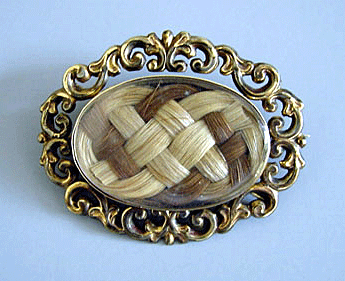 The
Victorians were obsessed with death. Life during those times was far
from easy and lots of people died young. Disease, childbirth, and the
harsh environment all contributed to the high mortality rate. As a
result, the specter of death was a persistent presence that permeated
the lives of Victorians. Not only did people follow strict mourning
rituals, but they also wore jewelry to remind them of a loved one. For
much of this mourning jewelry, human hair was the primary ingredient. The
Victorians were obsessed with death. Life during those times was far
from easy and lots of people died young. Disease, childbirth, and the
harsh environment all contributed to the high mortality rate. As a
result, the specter of death was a persistent presence that permeated
the lives of Victorians. Not only did people follow strict mourning
rituals, but they also wore jewelry to remind them of a loved one. For
much of this mourning jewelry, human hair was the primary ingredient.
While mourning jewelry has been around since at least the 17th century,
most people associate it with the Victorian Era, when mass production
made it affordable.
Long before photography, and when painted portraits were outside the
realm of affordability for most people, it was still important for
people to have a personal keepsake of a loved one. In the 17th century,
jewelers created medallions with the deceased’s initials in gold on a
background of woven hair set under crystal. Loved ones and friends often
wore these as a memorial to a recently deceased loved one.
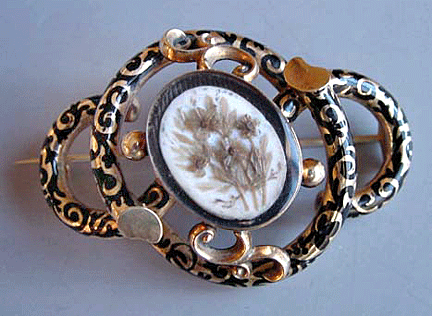 The
trend reached its peak after the death of Prince Albert in 1861, when
Queen Victoria, as well as members of her court, wore black clothing and
matching mourning jewelry for several decades. The
trend reached its peak after the death of Prince Albert in 1861, when
Queen Victoria, as well as members of her court, wore black clothing and
matching mourning jewelry for several decades.
Thanks to Queen Victoria, black jewelry became quite fashionable.
Jewelers fashioned the best pieces out of jet, a fossilized coal found
near Whitby, England. Less expensive alternatives included black glass,
black enamel, vulcanite, a hardened rubber, and bog oak, which is more
of a brown color but still dark enough to express somber sentiments.
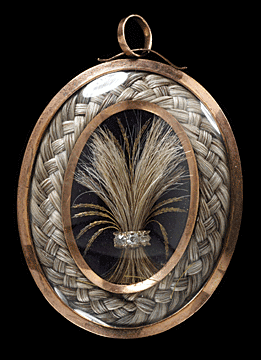 Early
hair jewelry was usually made in cooperation with goldsmiths producing
beautiful and expensive creations of hair mounted in gold and often
decorated with pearls or precious stones. Pieces constructed with
precious materials by artisans were naturally very expensive. Early
hair jewelry was usually made in cooperation with goldsmiths producing
beautiful and expensive creations of hair mounted in gold and often
decorated with pearls or precious stones. Pieces constructed with
precious materials by artisans were naturally very expensive.
The popularity of hair jewelry peaked in the 1850s but after the Civil
War there was a trend to producing artwork from hair. Hair artisans
created pictures and mosaics under glass domes or in frames using hair
from different people in different colors. They created hair trees from
hair from each family member using a picture of the family, ribbons,
dried flowers, butterflies and even stuffed birds. They also wove
wreaths of hair.
Makers of hair jewelry obtained hair for all of these various uses from
cuttings of the deceased's head or collected from hair brushes. Prior to
the mid 19th century, they stored this hair in cloth bags until they had
gathered enough to make a piece. In the last half of the century, makers
of porcelain and ceramics began to produce pieces designed specifically
to hold hair.
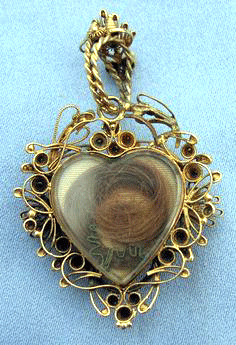 Women
painstakingly wove human hair into bracelets, necklaces, and rings.
However, the hair wasn’t necessarily from the deceased. In the mid-19th
century, mourning jewelry makers imported 50 tons of human hair annually
into England. To create a connection to a deceased loved one, jewelers
often discreetly wove the initials of the deceased into the jewelry
object. Women
painstakingly wove human hair into bracelets, necklaces, and rings.
However, the hair wasn’t necessarily from the deceased. In the mid-19th
century, mourning jewelry makers imported 50 tons of human hair annually
into England. To create a connection to a deceased loved one, jewelers
often discreetly wove the initials of the deceased into the jewelry
object.
Lockets were also popular. Some contained a lock of the deceased
person’s hair. Other lockets held a photo of the dearly departed.
Mourning rings were the most common form of early mourning jewelry in
the 18th century. People gave them to family members and close friends,
paying for them through the estate of the deceased.
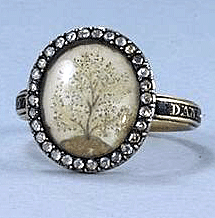 During
the first two decades of the 19th century, rings were still the most
common form of mourning jewelry, but brooches and miniatures set in
pendant settings began to gain favor. Often these pieces incorporated
the hair of the deceased into their designs. Brooches featured woven
plaits or cut curls and feathers of hair set in compartments under
glass, while miniaturists would either glue hair onto the surface of the
picture or grind it up and mix it with the paint. Each piece could also
be set with a different color braid of hair, faceted jet beads and seed
pearls, which were a symbol of tears. Jet and hair continued to be used
in mourning jewelry until the end of the 19th century. During
the first two decades of the 19th century, rings were still the most
common form of mourning jewelry, but brooches and miniatures set in
pendant settings began to gain favor. Often these pieces incorporated
the hair of the deceased into their designs. Brooches featured woven
plaits or cut curls and feathers of hair set in compartments under
glass, while miniaturists would either glue hair onto the surface of the
picture or grind it up and mix it with the paint. Each piece could also
be set with a different color braid of hair, faceted jet beads and seed
pearls, which were a symbol of tears. Jet and hair continued to be used
in mourning jewelry until the end of the 19th century.
The etiquette for mourning dress also became extremely elaborate and
stringent during the Victorian era. The 25th edition of the Rules of
Etiquette and Home Culture, published in 1893, describes how the deepest
mourning for a widow should last two years. During the first year of
mourning, she could wear only black wool without any trimmings or
jewelry except for jet pins and buckles. Women wore black silk with
white collars and cuffs and jet jewelry during the second period of
mourning, which lasted six months. Mourning etiquette permitted items of
clothing in gray, white, and violet during the last six months of
mourning along with jewelry made of jet, gold, and other dark colored
materials such as onyx, hair, and tortoiseshell.
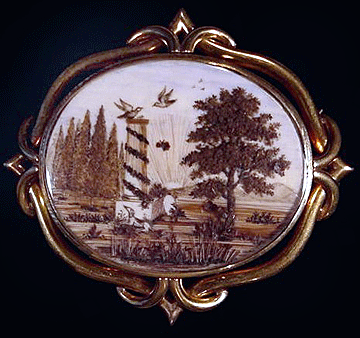 Human
hair mourning jewelry grew in popularity because human hair doesn’t
decay with the passing of time. Hair has chemical qualities that cause
it to last for hundreds, possibly thousands, of years. Additionally, by
the 19th century many hair artists and wig makers had lost most of their
customers after powdered wigs went out of fashion. Human
hair mourning jewelry grew in popularity because human hair doesn’t
decay with the passing of time. Hair has chemical qualities that cause
it to last for hundreds, possibly thousands, of years. Additionally, by
the 19th century many hair artists and wig makers had lost most of their
customers after powdered wigs went out of fashion.
Hair jewelry workshops existed throughout Europe. Buyers of human hair
traveled the countryside and purchased hair from poor peasants,
sometimes in exchange for a scarf, ribbon or other small luxury object.
In addition to the needs for hair jewelry, there was still a need for
great amounts of hair for braids and switches that women wanted to
purchase for their coiffeurs. Hair artisans made most hair jewelry,
however, from a person of special interest's hair, whether that was a
famous figure or a family member or friend.
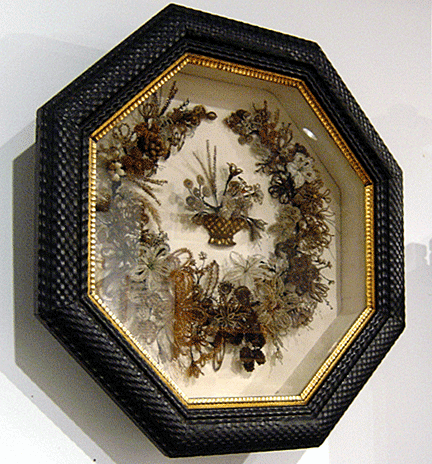 Many
women of the 19th century began crafting their own hairwork in their
homes. In America, popular magazines of the period, like Godey's Lady's
Book, printed patterns and offered starter kits with the necessary tools
for sale. Books of the period, like Mark Cambell's Self-Instructor in
the Art of Hair Work offered full volumes devoted to hairwork and other
"fancywork," the common name for predominately female crafts at the
time. Many
women of the 19th century began crafting their own hairwork in their
homes. In America, popular magazines of the period, like Godey's Lady's
Book, printed patterns and offered starter kits with the necessary tools
for sale. Books of the period, like Mark Cambell's Self-Instructor in
the Art of Hair Work offered full volumes devoted to hairwork and other
"fancywork," the common name for predominately female crafts at the
time.
Another reason for the construction of hair jewelry in the home was a
lack of trust in commercial manufacturers. They were concerned that the
hair used in the jewelry wouldn’t be the hair that had been given to the
jeweler, having been substituted with hair from someone else.
People mostly abandoned the practice of rigorous mourning codes along
with the use of mourning jewelry in the early 20th century.
To see some fine examples of mourning hair jewelry, visit the Dearborn
Historical Society in Dearborn , Michigan or the Swedish Institute in
Minneapolis, Minnesota.
<
Back to More Antique Spotlights
Next Article > |
